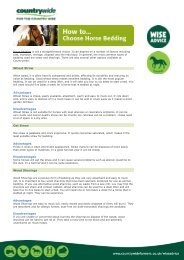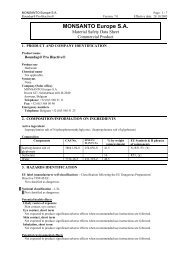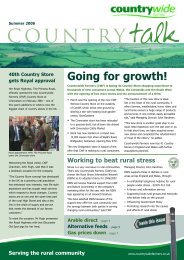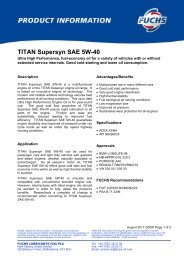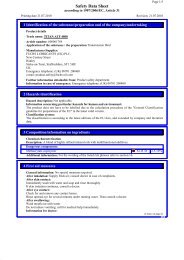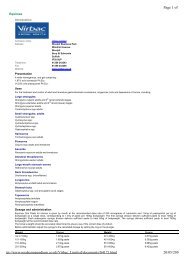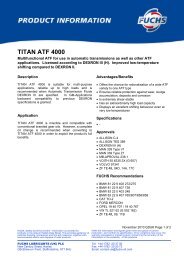Maize Kicka - Countrywide Farmers
Maize Kicka - Countrywide Farmers
Maize Kicka - Countrywide Farmers
You also want an ePaper? Increase the reach of your titles
YUMPU automatically turns print PDFs into web optimized ePapers that Google loves.
Kicking your <strong>Maize</strong> crop offto the best possible start.Cost of Growing a <strong>Maize</strong> CropIf all expenditure is taken into consideration, it costs a similar amount to grow a 40t/haforage maize crop as 10t/ha of winter wheat. The same level of management andattention to detail should be applied to both, particularly as a maize crop only has half thetime to achieve a similar dry matter yield. Therefore there is less opportunity for the cropto recover from a poor start and correct nutrition is key.Growing Forage <strong>Maize</strong>The development of earlier maturing varieties has allowed <strong>Maize</strong> to become a wellestablished crop in the UK although conditions are not ideal for its growth with marginalheat units during the growing season compared to the continent. We frequently getvariable crop performance under cool, wet and dull conditions when nutrient availability isreduced. Nutrition, particularly during establishment plays a key role in achievingconsistent high yields of quality forage with the aim of ensuring that nutrients are not alimiting factor.Rapid Early EstablishmentAs highlighted above, with a short growing season, earlyrapid growth is critical – if the crop stands still for a couple ofweeks, it will not be able to compensate and final yield willsuffer.The initial root grows from nutrients within the seed but afterapproximately 14 days the seed will run out of Phosphate, acritical element for root development. The seedling is thenreliant on nutrients in the soil but availability to the small rootsystem may be limited by conditions such as cold, dry, poorseedbed, water-logging, too acidic etc.This can be overcome by using the starter fertiliser <strong>Maize</strong><strong>Kicka</strong> placed in a band approximately 2 inches beneath andbeside the seed.Starter Fertiliser – <strong>Maize</strong> <strong>Kicka</strong><strong>Maize</strong> <strong>Kicka</strong> has been designed as a starter fertiliser with the nutrients required to enablethe crop to develop rapidly from an early stage. By placing it in a band just below and toone side of the seed, the size of the root system is not important. <strong>Maize</strong> <strong>Kicka</strong> shouldtypically be applied at 125kg/ha (50kg/ac) and contains 18% N, 20% P 2 O 5 , 27.5% SO 3 ,Zinc + <strong>Kicka</strong>.What do the different components do?• Nitrogen and Phosphorus - Trials work has proven that if the crop is deficient ineither N or P during the early stages of development (emergence to 8 leaves), thenumber of potential grain sites will be limited. is can be seen through a reduction in cob‘snouting’ where <strong>Maize</strong> <strong>Kicka</strong> technology has been used (see pictures on next page).P is also very important for root development which can get the crop into a viciouscircle:- Poor P availability = poor root development = poor nutrient availability. Navailability will also impact on this. P is locked up by Ca, Al & Fe but by applying it in a
and, the fixing capacity of the soil is overcome therefore making the nutrientsavailable to the small root system. This only occurs where significant quantities ofphosphate are applied in a banded application.• Sulphur plays a key role in nitrogen utilisation and as atmospheric depositiondecreases more incidences of crop deficiency are seen and exacerbated by highrainfall as it is very soluble.• Zinc is an important micronutrient for the maize crop and is involved in manybiochemical pathways. It is ‘locked up’ in high pH soils and when Phosphorus is athigh levels. By supplying zinc though a banded application at drilling these issues areovercome making zinc available to the developing plant.• <strong>Kicka</strong> is a key component in the product which has been proven to help the maize cropin a number of ways. It increases protein and auxin synthesis benefiting root vigourand size (mass and length); it also increases the chlorophyll content of leaves raisingphotosynthetic efficiency.Untreated+ <strong>Kicka</strong> Technology UntreatedReduced ‘snouting’Increased rooting<strong>Maize</strong> Nutrient SupplyMany forage maize crops have organic manuresapplied to them and their nutrient content must becalculated. If no FYM is applied, all the nutrientsmust be supplied via fertilisers if the crop is going toperform and the soil is not going to be depleted.A typical 40t/ha crop grown where the indices are N =0, P = 2, K = 2- requires 120 kg/ha N; 60 kg/haP 2 O 5 ; 180 kg/ha K 2 O and approximately 50 kg/haSO 3. In many situations, most of the P and K isapplied via the FYM although most of this is plougheddown below the early root system.<strong>Maize</strong> <strong>Kicka</strong> applied at 125kg/ha will supply22.5kg/ha N, 25kg/ha P 2 O 5 and 34.4 kg/ha SO 3 whichmeans that often only N (+S) will have to be applied.Where no FYM is applied, the nutrients in <strong>Maize</strong><strong>Kicka</strong> should be calculated as part of the fertiliserinputs.4” 10cm8”20cm<strong>Maize</strong> <strong>Kicka</strong> Payback<strong>Maize</strong> <strong>Kicka</strong> Technology has been proven to:-Increase ROOT BIOMASS by 20%.Increases fresh weight YIELD by an average 1.2 T/ac (3 T/ha)Bring the crops MATURITY forward by 7-10 days.Seed Depth5 – 7 cmPlaced Fertiliser Depth5cm below & besideFYM Ploughedto this depth
Responses to <strong>Kicka</strong>Trials work has proven that the “<strong>Kicka</strong>” part of <strong>Maize</strong> <strong>Kicka</strong> has given excellent increasesin both fresh weight and starch yield.Fresh Weight YieldStarch Yield1918.85.85.7Tonnes / Acre18.51817.517.97.5%17.5Untreated125kg/ha MAPMAP+<strong>Kicka</strong>Tonnes / Acre5.65.45.255.27.5%5.3174.8Equivalent to an additional £240/ac worth of milkRecommendationsPlace at the time of drilling in a band 5cm below and to one side of the seed. Accurateplacement is important if the product is to perform as expected.Rate is dependant on soil phosphate level as responses to <strong>Maize</strong> <strong>Kicka</strong> have still beenachieved but only a reduced rate is required.Rate:- Phosphate index 2 and below – 125 kg/ha (50 kg/ac)Phosphate index 3 and above – 62.5 kg/ha (25 kg/ac)The Benefits of <strong>Maize</strong> <strong>Kicka</strong> are:-1. Ensures the supply of essential nutrients to a seedling crop…. even in lessfavourable conditions like cold, dry, cloddy etc seedbeds.2. Reduces the likelihood of the crop going yellow and standing still during earlydevelopment.3. Provides all the additional nutrients required by the crop in many situations whereFYM is used.4. Ensures that the crop roots get to the ploughed down FYM, especially where muchof the P & K is being supplied by organic manures.5. The maize gets the nutrients and not the weeds near the surface.6. Risk of P runoff is reduced.7. Achieves an earlier maize harvest date.8. Helps ensure a consistent maize yield performance.Supply<strong>Maize</strong> <strong>Kicka</strong> is available by agreement through <strong>Countrywide</strong> <strong>Farmers</strong>.<strong>Kicka</strong> is a registered trade mark of Masstock Arable (UK) Ltd.



